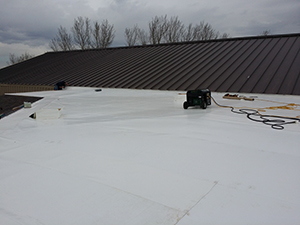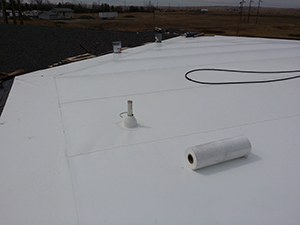TPO roofing is one of the most popular commercial roofing systems in the Midwest thanks to its energy efficiency, heat-welded seams, and long-term dependability. Building owners across Marshfield, WI continue to choose TPO for its durability, cost-effectiveness, and proven performance in extreme weather. But
This guide from Golden Eagle Roofing explains what affects TPO longevity, how maintenance plays a role, and what to expect from manufacturer warranties. To learn more, call 608-633-6719 and speak with an expert today.

How Long Does TPO Roofing Last?
How long does TPO roofing last, and what steps help maximize its lifespan? Let’s examine the facts.
Typical Lifespan of TPO Roofing
A professionally installed TPO roofing system generally lasts 20–30 years, depending on membrane thickness, installation quality, routine care, and environmental conditions. TPO is manufactured in several thickness options, typically 45-mil, 60-mil, and 80-mil. While thinner membranes may perform well for many years, thicker options offer stronger puncture resistance, longer weathering ability, and increased durability. Many commercial buildings in Wisconsin benefit from choosing the thicker membrane to withstand year-round temperature fluctuations.
One of the primary advantages of TPO is its heat-welded seam technology. When welded correctly, these seams create a strong, watertight bond that is significantly more durable than taped or glued seams used on older systems. These welded seams are one of the main reasons TPO roofs often reach or exceed their expected lifespan.
How Weather Impacts TPO Roofing
Wisconsin’s weather patterns play a significant role in determining how long a roofing system lasts. TPO performs exceptionally well in climates with large temperature swings because the membrane can expand and contract without cracking. Marshfield’s winter freezes, spring thaws, and summer heat cycles test every commercial roof, and TPO has proven to manage these conditions reliably.
Its reflective white surface also helps reduce heat absorption in summer, lowering rooftop temperature and reducing strain on HVAC systems. This energy-efficient performance supports both comfort and cost savings for commercial buildings.
However, snow loads, ice formation, high winds, and debris can affect any roofing system. This is why installation quality and ongoing upkeep are essential to maximizing the service life of TPO roofing.
Maintenance Steps That Extend TPO Lifespan
TPO roofing is considered a low-maintenance system, but consistent care significantly increases its longevity. A TPO roof that is properly maintained often lasts closer to 30 years rather than the lower end of the lifespan range.
Key maintenance practices include:
Routine Inspections: Annual or semi-annual inspections, especially after storms, help identify seam stress, punctures, flashing issues, or membrane wear before these problems turn into leaks. Inspections should include drains, curbs, penetrations, and rooftop accessories.
Cleaning the Membrane: Keeping the membrane clean improves reflectivity and helps prevent dirt buildup that can affect water flow. A cleaner membrane also helps maintain energy-efficiency performance.

Managing Rooftop Traffic: Commercial roofs with frequent mechanical or HVAC traffic are more prone to punctures. Installing walk pads in high-traffic areas provides long-term protection for the membrane.
Addressing Repairs Promptly: One of TPO’s strengths is its weldable surface, which allows technicians to make durable, efficient repairs. Fixing minor issues early prevents premature aging and avoids major moisture-related damage.
Documenting Work for Warranty Compliance: Keeping a log of inspections, repairs, and maintenance helps maintain warranty coverage and ensures the roofing system remains in peak condition.
With proper care, many TPO roofs exceed their expected service life and continue to perform exceptionally well.
Understanding TPO Roofing Warranties
Most TPO manufacturers offer warranties ranging from 15 to 30 years, based on membrane thickness, installation details, and the contractor’s certification level. Warranty terms often consider:
- Membrane thickness
- Installation method (fully adhered, mechanically fastened, or hybrid)
- Required insulation or coverboard
- Recommended maintenance schedule
- Roof slope and drainage design
A warranty provides valuable long-term assurance, but it is only valid when the roof is maintained correctly. Neglected maintenance can void coverage, making routine inspections essential for protecting your investment.
Is TPO Roofing a Good Long-Term Choice?
For commercial buildings in Marshfield, WI, TPO roofing offers a strong balance of lifespan, durability, energy efficiency, and repairability. When installed by an experienced professional and supported by consistent maintenance, TPO roofing stands out as one of the most cost-effective long-term systems available.
Trusted TPO Roofing Specialists
If you are considering TPO roofing for your commercial facility or want an expert evaluation of your current system, Golden Eagle Roofing provides top-quality installation, inspections, and long-term maintenance solutions. Our team helps building owners maximize roof lifespan, protect their warranty, and prevent costly repairs through proactive service.
Contact Golden Eagle Roofing today at 608-633-6719 to schedule an assessment or request a roofing estimate.
FAQ
What thickness of TPO roofing lasts the longest?
Thicker membranes, especially 60-mil and 80-mil, provide stronger puncture resistance and better durability, making them the best choice for long-term performance.
Can TPO roofing be repaired easily?
Yes. Because TPO is heat-weldable, repairs can be made quickly and securely. This weldability allows for long-lasting fixes and helps maintain the roof’s waterproof integrity.
Does TPO roofing help reduce energy costs?
Its reflective surface helps keep rooftop temperatures down, which reduces strain on air conditioning systems and can significantly cut cooling expenses during warm weather.
